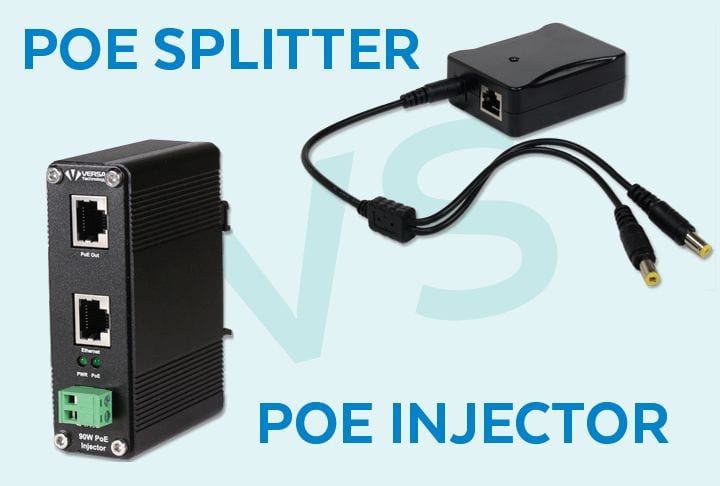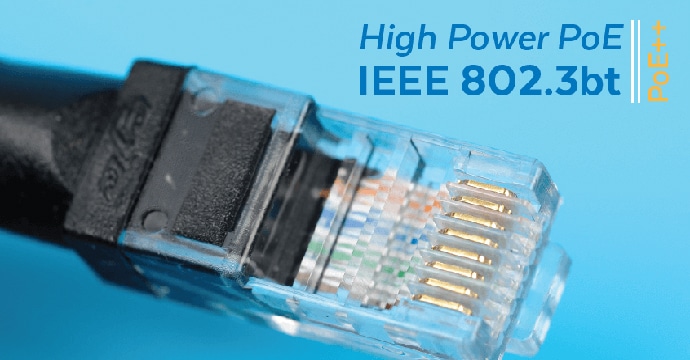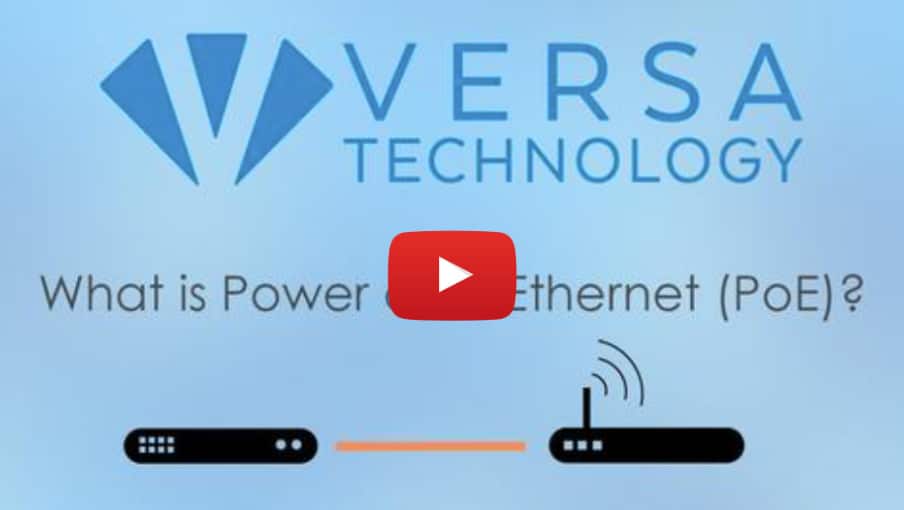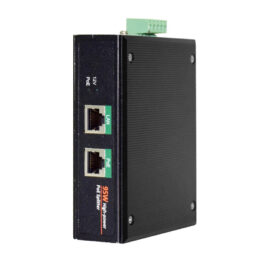PoE splitters are devices used in conjunction with power source equipment (PSE) such as PoE switches and PoE injectors. While not strictly a PSE, the PoE splitter is an intermediary device that supplies power in a PoE network. PoE splitters differ from PoE PSEs. Instead of taking power and data input and turning them into a singular output, the PoE splitter supplies power by separating (splitting) the power from the data and feeding it into a different input that can be used by a non-PoE PD. In general, PoE splitters are used when an IT professional needs to place a non-PoE-compatible device in an isolated area without access to an electrical outlet.
Browse and purchase directly, or reach out to us if you need some project guidance.
FAQ's Power over Ethernet Splitters
Do I need a PoE Splitter?
If you have powered devices (such as IP cameras, VoIP phones, IP door readers, etc.) that are not PoE compliant, you may need a PoE splitter.
Can a PoE splitter be used as an injector?
Yes. A PoE splitter can be used to connect a non-PoE powered device to a PoE switch, hub, or PoE injector.
What’s the difference between a PoE splitter and a PoE injector?
The PoE splitter and PoE injector are commonly used PoE devices; however, they work in opposite ways. A PoE injector (also called a midspan) injects power to data that comes from a non-PoE switch (or endspan). It delivers both power and data to the powered device.
While a PoE splitter also supplies power to powered devices, it works in the opposite direction by splitting the power from the data into separate cables and delivering it to powered devices.
Insights from the Blog
PoE Calculator
This calculator allows you to determine the voltage that will be delivered to the remote PoE device.
Other PoE Resources
We're Here to Help!
Not sure which PoE Device is right for you? Send us a short message here and a Versa technical partner will assist you shortly. Have an urgent need? Use the chat below during regular business hours.
What is Power over Ethernet?
Power over Ethernet, or PoE for short, is a technology that can transmit power and data via a standard Ethernet cable. PoE allows network administrators to deploy Powered Devices (PD's) at nearly any location. Watch the following video for a quick rundown.
S69-210 Industrial Gigabit 802.3bt PoE Splitter
- Ports: 2 x 10/100/1000Mbps RJ45
- Standard: IEEE 803.2bt
- PoE Input Budget: 90W
- Output Power: 72W DC, 12V/6A (full load)
- Surge Protection: 4KV
- Operating Temp: -40°C to 75°C
- TAA Compliant, made in Taiwan
The PoE Splitter and How it Works
PoE splitters are devices used in conjunction with power source equipment (PSE) such as PoE switches and PoE injectors. While not strictly a PSE, the PoE splitter is an intermediary device that supplies power in a PoE network. PoE splitters differ from PoE PSEs. Instead of taking power and data input and turning them into a singular output, the PoE splitter supplies power by separating (splitting) the power from the data and feeding it into a different input that can be used by a non-PoE PD. In general, PoE splitters are used when an IT professional needs to place a non-PoE-compatible device in an isolated area without access to an electrical outlet.
The unit itself is quite compact and consists of two cables—one cable provides power, the other supplies data. Simply put, the PoE splitter upgrades the non-PoE device to PoE.
VX-Pi1000SP Gigabit PoE Splitter
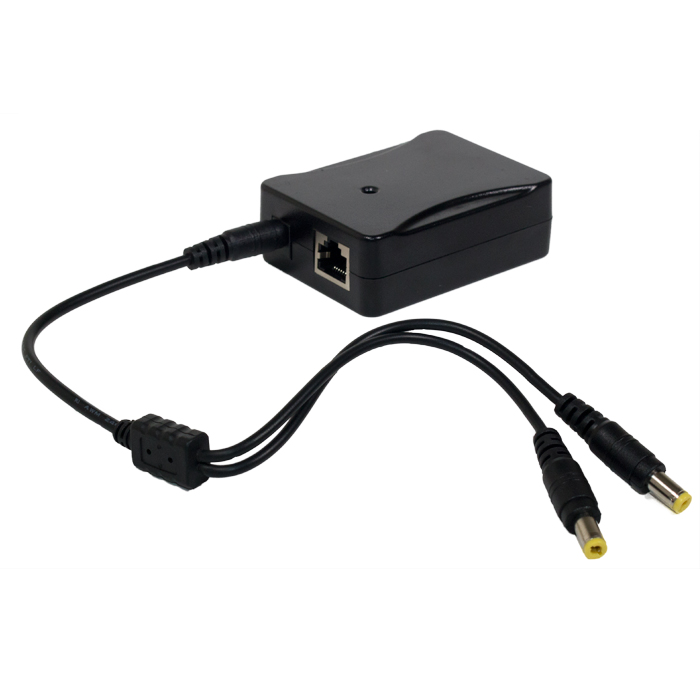
How a PoE Splitter Works
There are two scenarios that call for the use of a PoE splitter. One is a network in which a PoE switch needs to be connected to a non-PoE-compliant device. The other is a network where data is sent through a non-PoE network switch or router with PoE-compliant or non-PoE compliant end devices.
In the case where a PoE switch delivers both power and data but needs to power a non-PoE device:
The input cable connects directly to the PoE switch. The PoE splitter has two output cables: one to supply power and the other to supply data to the non-PoE device. The PoE switch sends both power and data to the PoE splitter over one Ethernet cable. The PoE splitter then separates the power and the data into its two different cables, and then sends both onto the non-PoE end device.

Should there be a combination of non-PoE and PoE-compliant devices (as in the second scenario described above), the PoE splitter should never be directly connected the the non-PoE switch. In this case, a PoE injector will be needed to supply power.
PoE Splitters and PoE Injectors Often Work Together
When building a strong PoE network, both the PoE splitter and PoE injector are major devices that are often deployed. And they frequently work in pairs. For example, the PoE injector sends both power and data to the PoE splitter on a single cable. The PoE splitter then splits the power from the data into two separate cables to make network devices work.
How to Install a PoE Splitter
As was discussed above, a PoE splitter is generally used when the devices to be powered (such as IP cameras, VoIP phones, WiFi radios, and IP door readers are not PoE compliant.
Installation is simple and can be completed in mere minutes. Let’s take the example of connecting a non-PoE IP camera to a PoE switch:
Step 1: Connect the PoE splitter’s two output cables to the appropriate interfaces of the IP camera—one for data, the other for power.
Step 2: Next, connect one end of the UTP cable (we recommend Cat5e or better) to the PoE splitter and the other end to the Gigabit RJ-45 port on the switch.
Step 3: At this point, power and data are ready to be transported to the IP camera.
PoE Splitter Features
- Can be IEEE 802.3af, 802.3at, or 802.3bt compliant
- Plug-and-play
- Two detachable power cables of different sizes (added flexibility)
- Short circuit protection
- Temperature monitoring
- Protects wireless LAN devices from power surges
- Has an adjustable output range of 12V, 9V, 7.5V, and 5V
- Supplies DC power and data to non-PoE devices
- Ideal for remote power-feeding applications, such as Bluetooth AP, VoIP phones, wireless access points, and IP cameras
- Comes in a hardened industrial version
- Provides reliable and safe power over existing Ethernet infrastructure
How a PoE Splitter Saves Money
A PoE splitter is an inexpensive piece of equipment that enables a user to add networking devices to a remote location without the expense of installing an electrical outlet. It also allows users to keep more expensive legacy devices and connect them to newer, more efficient PoE devices.
Power over Ethernet (PoE) Standards
The Institute of Electrical and Electronics Engineers (simply called the IEEE) has defined three 802.3 standards for PoE technology. Each standard has a different power budget. Following are the particulars:
- Type 1 (802.3af, also called PoE) has a power budget of 15.4 watts (W) and delivers 12.95W to the device after normal power dissipation in the cable.
- Type 2 (802.3at, or PoE+) has a maximum power budget of 30W, with 25.5W available to the PD.
- Types 3 and 4 (802.3bt, or PoE++) increase the maximum power to 60 to 100W and use all four twisted pairs of wires to transport the higher power. Type 3 has a max power of 60W, with 51W to the PD. Type 4 has a power budget of 95 to 100W, with 71W remaining to power up the PD.
Generally speaking, PoE splitters are compliant with IEEE 802.3af/at standards. Industrial PoE splitters usually adhere to the IEEE 802.3bt standard.

What to Look For When Buying a PoE Splitter
1) Make sure the PoE splitter purchased can work with the powered devices in the network.
2) Most PoE splitters comply with the IEEE 802.3af and 802.3at standards. Make sure the PoE splitter has enough power budget to power the PDs.
3) Make sure the PoE splitter’s PoE power standard matches with any PoE-compliant switches and injectors in the network.
To Sum Up
If your network is a combination of non-PoE-compatible devices, the PoE splitter is the ideal solution. These devices are inexpensive, can add years to the life of a network, and can save a good amount of time and money by eliminating the need for electrical outlets.
Versa Technology PoE Splitters
Versa Technology’s PoE splitters give users the ability to pair PoE power sourcing equipment (PSE) with non-PoE powered devices (PDs). PoE splitters essentially split the simultaneous transmission of data and power of an Ethernet cable and redirect power and data on separate interfaces. With a Versa Technology PoE splitter, you can easily convert your non-PoE PD into a PoE-ready device.
Stay Up to Date with our News
and Exclusive Offers
Join our expansive group of IT professionals who receive exclusive offers and the latest developments in the Telecom and Networking Industry.

